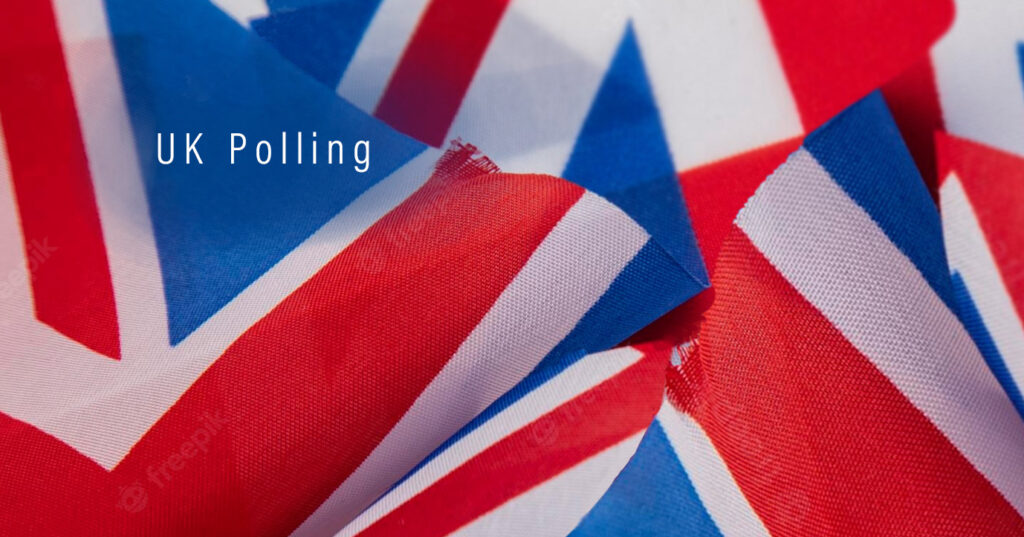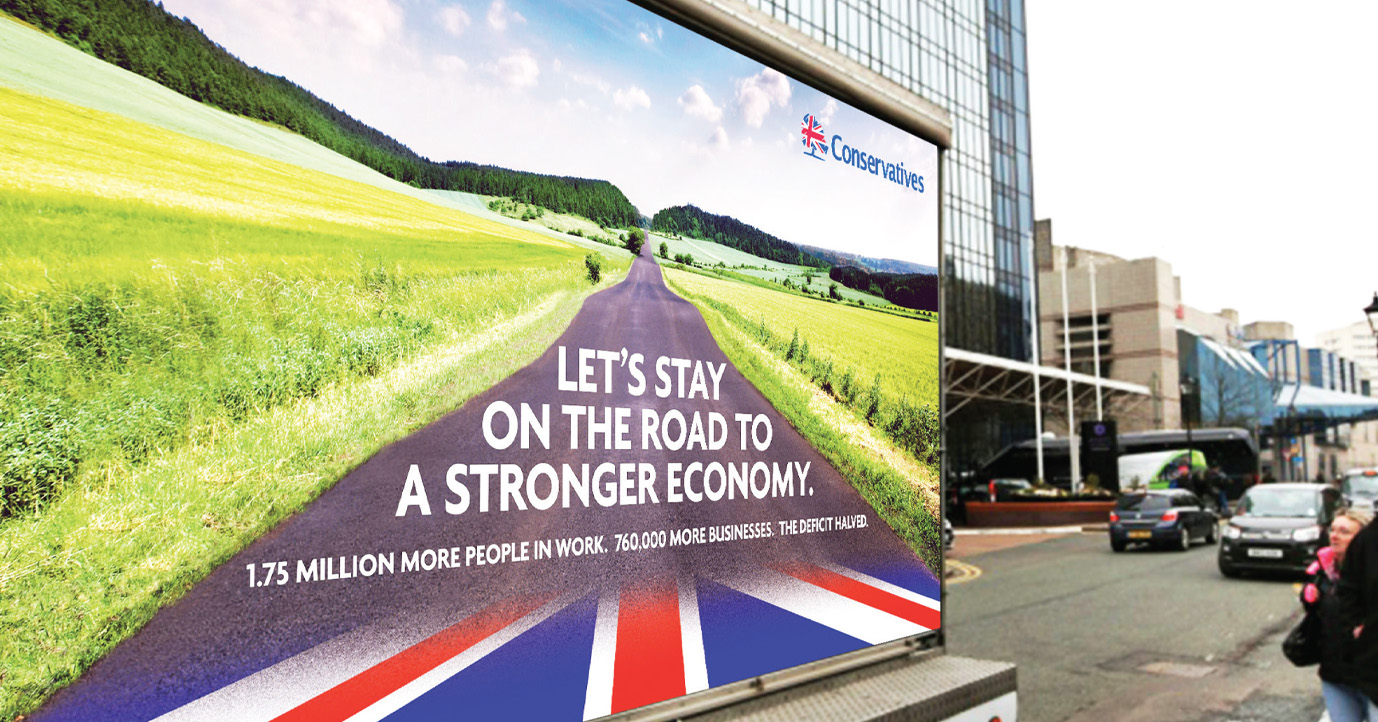
Below is the text of the polling presentation I gave in London this evening, including my latest national poll findings and new results from marginal seats in England and Scotland. Scroll down to find the presentation slides, marginals report, and full data tables.
—
Good evening and welcome. If you have ever wondered what a pollster does to celebrate his birthday, now you know. Somebody kindly asked me this morning if this was the big “four-O”, and I was compelled to admit this estimate was outside the margin of error.
This evening I will be unveiling my latest polling, both nationally and in the marginals, and giving my overview of where I think we are in the campaign that will end just nine weeks tomorrow.
This is the story of the parliament so far, as told by the nearly 2,000 national voting intention polls published since the last election. The scattering of dots should serve as a useful warning against reading too much into any one survey, but the trend is unmistakeable. Labour have fallen from their peak above 40% to the low thirties, from which the Conservatives have been unable to break free since the middle of 2012.
The Liberal Democrats, meanwhile, remain well below half their 2010 vote share, and UKIP have fallen back slightly from their peak at the end of last year.
In other words, the polls are not bringing much joy to anyone except the polling companies’ shareholders. But someone will be Prime Minister after May 7th, and one of the parties will take the lead in forming a government.
Over the next nine weeks the voters must make a decision. That decision will rest on three things: values, policies and personalities.
Let’s start with values – and this is from an 8,000-sample poll completed at the weekend.
If there is one positive attribute people associate with the Conservatives it is willingness to take tough decisions for the long term. They are also more likely than their rivals to be seen as competent, and people marginally more likely to think the Tories are clear about what they stand for – though only one third of people say it is true of them. Only just over a quarter think the Tories will do what they say, but it is a measure of the public view of politics that this is still more than say this is true of any of the others. Notably, people are twice as likely to think UKIP will do what they say than the Lib Dems.
Labour remains ahead on its traditional virtues of standing for fairness, being “on the side of people like me” and having its heart in the right place. But still only around one third of voters think Labour actually has these attributes, let alone any of the other parties.
On the issues, my large-sample Project Blueprint research has been tracking throughout the parliament whether people think the Conservatives, Labour or the Liberal Democrats have the best approach to different policy areas.
Labour’s lead on the NHS and schools has widened since 2011, and narrowed slightly over the last 18 months on tackling the cost of living, though they remain comfortably ahead here.
On immigration, the Tories remain well ahead of Labour – albeit by a reduced margin – when only the three main parties are included. But as I found in the Ashcroft National Poll last month, UKIP take the lead when they are introduced into the equation. This is the only area in which UKIP have the most popular approach.
The Tories, meanwhile, retain the advantage on most economic issues, especially the deficit, and retain a comfortable if slightly narrower lead on reforming welfare to stop benefit dependency. They are also, by a whisker, thought more likely than Labour to introduce practical policies that will work in the long run.
Looking in more detail at people’s views about the economy, it may be telling that I found people more likely than not – but only just – to agree that “the right decisions are being made and things will improve significantly in the next year or two”. Just over a year ago a majority preferred the alternative statement, “in a year or two the economy will be no better, or even worse, than it is now.”
How people expect to fare personally in any upturn is a different question. Fewer than one in five say they are already feeling the benefits of an economic recovery, while just over two fifths say that although they are not feeling the benefits yet, they anticipate doing do.
A stubborn four in ten, meanwhile, say they are not feeling any benefits from an improved economy and they don’t expect to. A majority of both Labour and UKIP voters say they expect any recovery to pass them by.
An important factor that plays a part in people’s willingness to let the Tories finish the job is whether they think the job is already finished, or indeed whether it should ever have been started.
I found just over four in ten agreeing that “the national economy is not yet fully fixed, so we will need to continue with austerity and cuts in government spending over the next five years” – a good basis for what I have described as the “coalition of the willing” the Tories need to assemble to stay in office.
Just over a third, though, think “enough already”, agreeing that “while a period of austerity was needed to fix the national economy, we don’t need another five years of cuts in government spending.”
For nearly a quarter, austerity was never needed in the first place.
What about the personalities?
Just under one third say they are satisfied with David Cameron’s performance as Prime Minister – a figure that has picked up slightly over the past year. A similar proportion say they are dissatisfied, but still prefer him as Prime Minister to Ed Miliband.
That leaves 38% who would rather see Ed Miliband in Downing Street than David Cameron, which includes just over three quarters of Labour voters. What the remaining quarter decide to do – whether they vote with their preferred party or their preferred leader – is clearly one of the biggest factors that will determine the outcome.
If you have been following my regular focus group reports, published every Monday alongside the Ashcroft National Poll, you will see that I have used different ways of uncovering people’s views of the leaders – by asking people to imagine them as animals, cars, drinks and so on. If this sounds like a frivolous thing to do, I think the results are quite telling. In fact I think if I show you the compilation of images suggested for each leader, you will be able to tell them apart.
Which party leader do you think undecided voters in our focus groups imagined as Fred from Scoobie Doo, a Smart car, a bottle of Babycham, and a Chihuahua in a handbag – and would be played in a movie of his life by Tom Cruise?
Yes – Nick Clegg.
How about this one: a fox, a Vesper Martini, a Mercedes, Dick Dastardly, and Hugh Grant?
Yes – David Cameron.
Who, then is represented by the hapless Elmer Fudd, a drink like a crème de Menthe that nobody would order, Mr Bean, and the Moon (because he seems to be in a world of his own)?
Yes – Ed Miliband.
That means the last one is easy. But which is the real Nigel Farage?
Is he the menacing Cruella de Ville, a weasel, a four-by-four with bullbars and the tough-guy actor Ray Winstone?
Or is he the harmless but entertaining Andy Capp, a peacock, a pimped Ford Capri with tinted windows, and Sid James?
That’s enough of that. How will all these factors – the values, the issues and the personalities – come together in the decision people make in May?
Analysis of my large-sample Project Blueprint polls has shown the part each of these things play in their decision to vote for one party or another, and how their position has changed over the last three years. This is how it plays out in the main battle, between Labour and the Conservatives:
The vertical axis shows the importance of each factor in people’s decision to vote for the Conservatives or Labour. The horizontal axis shows whether Labour or the Tories lead on that particular issue.
The Conservatives, then, want as many factors as possible in the top right quadrant. Labour want as many as possible in the top left.
The most important factors, which have actually increased in salience over time, are about values – whether a party wants to help ordinary people get on in life and whether they are “on the side of people like me”. Here Labour have a clear lead.
The one Tory advantage on an issue of above average salience is over whether they will do what they say – but as we have already seen, the lead here is pretty negligible.
Throughout the parliament the Conservatives have led on both economic management and overall leadership. But as those leads have increased, they have become less salient.
At the same time, while immigration and welfare reform have increased in salience, the Conservative lead on them has narrowed.
The lesson here is not to emphasise again and again the difference between David Cameron and Ed Miliband – people can see that for themselves, as Elmer Fudd and Mr Bean will testify.
The point is to show why it matters – why it makes a difference which of them is in Number Ten. You might say, to coin a phrase, that David Cameron needs to weaponise himself.
With UKIP voters, my research has shown the attraction is more about values and attributes than policies, and this illustrates which ones matter. Here, the vertical axis shows the relevance of each factor in people’s voting decision, and the horizontal axis shows the proportion saying each attribute applies to UKIP.
UKIP supporters think their party is clear about what it stands for and wants to help ordinary people, but one thing stands out above all else – they think the party is on the side of people like them.
My poll revealed another point about UKIP voters, particularly defectors from the Conservatives, that may defy some assumptions. It is often thought that Tory-UKIP switchers are overwhelmingly life-long Conservatives, but this is not the case.
My latest research found that among Tory switchers to UKIP, just under half said they had always voted Conservative. For more than a fifth of defectors, 2010 was the first time they had voted Conservative for a long time, or the first time ever.
My focus group research has helped reveal more about the decision voters are considering. We regularly ask people to say in their own words what the parties is trying to tell them, and what their main reservations are about each.
Labour’s main message, as heard by the voters, is “save the NHS”. They regard this as a good thing, on the whole. But most people are not sure how Labour intend to go about this, let alone solving some of the deep-seated problems they think the NHS faces, other than by spending more money – which is also (alongside Ed Miliband) the biggest reservation they have about returning Labour to office.
The essence of the Conservative message that people hear is “let us finish the job”, which will please Number Ten. But there is uncertainty about exactly what this entails and how long it will take. As one woman in a focus group asked, “just how long is this Long Term Economic Plan?”
More to the point, and to return to our observations about the recovery and the future of austerity, how will they benefit when it is complete? As one man put it, “I work in the public sector and my concern is that they really will finish the job”.
If people have heard anything from the Liberal Democrats – which is by no means a given – it is a promise to balance the extremes of the other parties. The doubt is whether the party have really shown it has the capacity or even the willingness to do this. In Lib Dem areas, this concern competes with the usually good reputation of the local MP.
UKIP’s message is pretty unambiguous, and everybody has heard it. But even those who largely agree with them wonder what they have to say about other things that also matter when electing a government.
And even some who find Nigel Farage reasonable and refreshing wonder whether the party harbours unsavoury elements or has unattractive policies it is keeping under wraps.
The Greens want to save the world, which, again, doesn’t sound to most people like a bad thing. But people wonder how much this would cost them – and, as with UKIP, what their other priorities are.
All these things will ultimately be resolved in the marginal seats, which is where we now return. In this round I have looked at a further four seats the Conservatives are defending from Labour, plus – since you enjoyed them so much last time – another batch from Scotland.
First, the Conservative seats – Colne Valley, High Peak, Norwich North and the Vale of Glamorgan with majorities over Labour of between 8.8% and 10.6%. Although the Liberal Democrats came second in Colne Valley in 2010, I don’t think it is too controversial to consider Labour the main challengers this time round.
In three of the four seats the results are effectively too close to call.
I found Labour ahead by a single point in High Peak and Norwich North, and a one-point Tory lead in Colne Valley. The Conservatives retained a slightly more comfortable six-point margin in the Vale of Glamorgan.
So, back to Scotland. In the previous round, published last month, I looked mostly at Labour seats in areas which recorded a high Yes vote in the referendum. There I found an overall swing from Labour to the SNP of more than 25%, with swings in individual seats ranging from 21% to 27%.
This time I have looked at Labour seats in areas where support for independence was lower, including some of particular individual interest. I have also polled two more Lib Dem seats, as well the only current Conservative seat in Scotland.
I should say at this point that I have seen it suggested that the Tories should be targeting one or both of Angus or Perth & North Perthshire, on the rather optimistic grounds that they are only nine points behind the SNP in both constituencies. I hope nobody will be too deflated to hear that I have not polled these seats, since I regard the idea of the SNP losing seats to the Tories or anybody else as rather fanciful this time round.
So what did I find?
In the two Lib Dem constituencies, I found swings of more than 20% from the Lib Dems to the SNP, which would mean SNP gains both in Aberdeenshire West & Kincardine and in Charles Kennedy’s seat of Ross, Skye & Lochaber. Were such a result to be repeated across the board at the election, the Scottish Lib Dems would be reduced to a single outpost in Orkney & Shetland – though since I found a swing of only 15% to the SNP in the previous round in Gordon, they may yet be spared such a fate.
In Dumfriesshire, Clydesdale & Tweeddale, where David Mundell flies his solitary flag, I found a very tasty contest: a 13.5% swing to the SNP, which would mean a recount or even a toss of the coin were this snapshot to be repeated in nine weeks’ time.
In the Labour seats, I found a bigger range of swings to the SNP than was the case in last month’s batch. However, that will be little comfort to the Labour Party in Ayr, Carrick & Cumnock, or in Dumfries & Galloway, or in Alistair Darling’s current seat of Edinburgh South West, or even in Gordon Brown’s home constituency of Kirkcaldy & Cowdenbeath, where I found the biggest swing to the SNP of any Labour seat I have polled.
But what of Jim Murphy? Well, on the basis of this snapshot, after 7th May……he may be rather lonely in Westminster but at least he’ll be there.
Where, then, does this leave our analysis of the battleground? Pay attention – this is the sciencey bit.
As things stand, the Conservatives have 46 more seats than Labour in the House of Commons. Forty-six is therefore the Magic Number.
If, taken together, the number of net Conservative losses and net Labour gains is more than 46, Labour will be the largest party after the election.
If the combined total is less than 46, the Conservatives remain the largest party.
(If the combined total is 46, the parties will be the same size. What happens after that could depend on what sort of mood Her Majesty is in).
Of course, these Labour gains do not all have to be from the Conservatives, and vice versa.
My polling has found the Tories ahead in ten seats currently held by the Liberal Democrats. But I have also found Labour ahead in ten current Lib Dem seats – so no net advantage to either party there.
So to simplify, let’s assume for the sake of argument that Conservative and Labour gains from the Lib Dems cancel each other out – as do any seats that either party may lose to UKIP.
That takes us back to the giant spanner in Labour’s works that is Scotland. When we factor that in, this is the equation we have:
The Magic Number of forty-six, plus the total of Labour losses to the SNP – divided by two – is the number of Conservative seats Labour must gain to have the same number of seats in the House of Commons. (We have to divide by two to avoid double counting, because each Conservative loss is also a Labour gain).
If Labour held on to everything they currently have in Scotland, they would need to take 23 seats from the Conservatives to become the largest party. For every two seats they lose in Scotland, they have to take another from the Conservatives to compensate.
If, on the day, the swing to the SNP only reached 10%, only two seats would change hands. If the swing were to reach 15%, Labour would lose 19 seats.
But if the swing to the SNP reached 22% across the board, Labour could lose 36 seats to the SNP.
If that were to happen, the number of net gains Labour needed to make from the Conservatives for the parties to be the same size would be forty-one.
And of the 59 Conservative-held seats I have polled in which Labour are the principal challengers, I have found Labour ahead in……forty-one. That – and this is not a forecast – would give Labour and the Conservatives 272 seats each in the House of Commons.
But some of the results from my polling in those 41 seats were very close, and some of them are now several months old.
Both these scenarios may therefore be at the outside edge of expectations: 41 gains from the Tories might in fact be an ambitious target for Labour, and 36 gains from Labour might in reality prove a bit much for the SNP.
On the other hand, it is hard to see things getting any worse for Labour in Scotland, while things are on a knife-edge elsewhere.
But as things stand, Labour losses in Scotland could offset their gains from the Tories, leading to something close to a dead heat.
This, then, is the battle: can the Conservatives fight back against Labour faster than Labour can fight back against the SNP? It is just as well I never bet on politics.
There is plenty of time for movement before polling day. For the reasons I explained earlier, many voters have dilemmas to resolve over the next nine weeks. And as these numbers show, the outcome really will come down to the results in individual constituencies.
That is why I will carry on with both my polling both at the national level and in the marginals – the next instalment of which will investigate how far Labour can rely on some of the Conservative seats in which my previous polling has found them only slightly ahead.
Meanwhile, thank you for your attention and remember that everything you have seen this evening is a snapshot, not a prediction.
Thank you very much.


